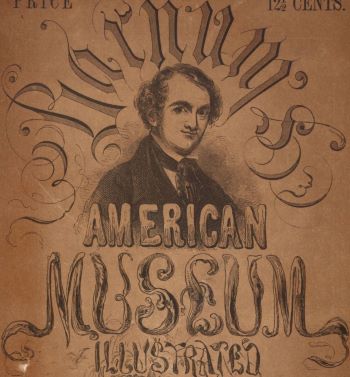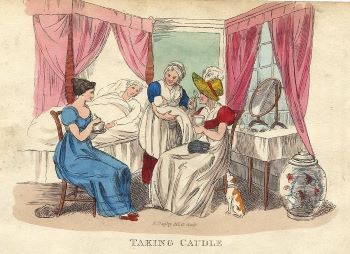I Never Wish to be a Millionaire
This isn’t the way I usually begin the weekly blog about Barnum’s copybook letters, but I just can’t resist telling you right away that I’ve come to a letter which tells us that at long last P. T. Barnum knows his wife Charity is “with child.” I discovered this in two letters, one written on December 19th and the other on December 21st, 1845, only ten weeks before his fourth daughter, Pauline, would be born. (Indulge me for a moment: I had been concerned that Barnum’s lack of awareness of Charity’s condition was putting a strain on their relationship, he believing that her loneliness and health complaints were nothing compared to what he was suffering on his own in Europe, and that her low spirits had no real cause.) We’ll get to that story after we explore a letter that shares Barnum’s thoughts on personal wealth, honor, and “gulling” the public–but at least you know where we’re headed.
Back in December of 1841, Barnum had done very well for himself convincing the owner of the marble building at Broadway and Ann Street to take a chance on him as the buyer of Scudder’s American Museum and its collections, which occupied much of the building. Francis Olmsted was the building’s owner, and through a clever purchasing arrangement Barnum made with Olmsted he became the museum’s proprietor, soon so successful that he was able to pay off his debt in less than two years. As grateful as Barnum was to have gained Olmsted’s trust at a time when he had little money to his name, his ongoing relationship with his landlord often seems to have been prickly, or so the letters suggest.
Over the course of late summer and fall in 1845, disagreements emerged time and again in their letters concerning a woman employed at the museum, whom we only know as “Frances.” Frances had worked there for years prior to Barnum becoming the museum’s proprietor, and she and Olmsted both felt she deserved a salary higher than anyone else Barnum could hire to do her work. At one point she left the job, but eventually returned. Barnum was miffed, as he felt he had been doing right by keeping her on, when he could have hired another (female) person for less money, including his own sister who was greatly in need of work. Despite that, he had deferred to Olmsted’s wish that Frances stay. While the back and forth on that topic is of moderate interest, it is the result of that discussion, spawning Barnum’s comments on the subject of money and wealth, that is most striking in his letter of December 17th, 1845. Barnum made his point to Olmsted in no uncertain words when he wrote,
You say that “although you are poor yourself you have through life had intercourse with men of such fortunes, that mine would be comparatively small.” I was obliged to laugh upon reading this—first at the idea of your calling yourself poor—second at the thought that you supposed I fancied myself rich! I guess your poverty will never be the death of you & I trust my riches will not keep me awake nights.
No sir, I am neither rich nor do I ever expect, or hardly wish to be. I only ask for a comfortable independence which will supply me with the comforts of life for self & family, and give me always a shot in the locker for the benefit of any unfortunate friend who may apply for relief. I never wish to be a millionaire—for I can be happier without being so, and I do not love money well enough to make myself an eternal slave in guarding it—but if I know my own heart I wish to see all men prosperous & happy, and ask nothing which is not clearly right from any man or woman living. When persons can truly assert that I am penurious and do not render full value for all services rendered then I would despise myself—but when my purse, small as it is, is to be made the foundation for increased demands on it—I bolt.

Today many people casually speaking of Barnum refer to him as a huckster, scammer or con artist who swindled his audiences, characterizations that hardly seem fair. In Barnum’s time, much entertainment was based on the “incredible”—things that amazed people and which may or may not have been real (keep in mind, no Internet or National Geographic to showcase the wonders of the world to people then). Or the things might be real enough, but were paired with stories that were not entirely truthful—imaginative tall tales. Barnum’s museum contained thousands of “genuine” artifacts and artwork (granted, he did have copies of famous paintings made) but he relied on quirky and questionable things to get people in the door, and mainly wanted people to be curious, and enjoy and return to his museum. Afterall, think of the new image technologies and inventions he was showing! He was far from being the only showman fooling people with humbugs, and he made it a point to stay clear of hoaxes, which he regarded as cruel jokes in contrast to the humbug’s simple purpose to amuse and entertain. In this next part of Barnum’s letter to Olmsted, he provides some insight into his views on his interacting with the public versus individuals.
As for the public, I look upon it quite different from an individual. The truth is the public are not always the most just, nor benevolent body that we can conceive of, and therefore I can sometimes see them “done” without shedding many tears, and I do not consider a man as being swallowed up in moral turpitude because he gulls the public a little occasionally, if he will at all times be strictly honorable in all his intercourse with individuals.
Signing off with a gesture of friendship, he wrote, “Hoping soon to have the pleasure of taking you by the hand, I am dear sir as ever your sincerest & grateful friend, ‘Old Barnaby.’” The latter refers to the character name “Barnaby Diddledum” from a series Barnum had written in 1841 for the New York Atlas, a Sunday paper. Olmsted probably first learned of Barnum from an editor of that newspaper who had vouched for Barnum at the time he was trying to purchase the American Museum. One can imagine that ever after, Olmsted referred to Barnum as “Old Barnaby” since the story series drew heavily on Barnum’s own adventures.
Barnum’s long letters to his museum manager, Fordyce Hitchcock, who was both an employee and a trusted friend, not only provide interesting details about plans for the American Museum and the business of operating it, but also insights into more personal matters. Barnum hinted on more than one occasion that he not only valued their relationship but with pleasure saw signs that mutual good feelings were budding in their respective families, and hoped the Hitchcocks and Barnums would soon enjoy one another’s company as close friends. So it is not surprising that Barnum wrote to Hitchcock about the conflicting emotions he was experiencing, having learned of Charity’s pregnancy and thus realizing that her pleas for him to return home sooner rather than later had been justified. Sharing his feelings, he wrote,
I very much wish to sail for home 1st Feb on account of the situation of my family [writing runs off bottom of page] I determined at all hazards to go, but considering the dangers of crossing in the winter in a steamer, as well as the very great sacrifice I should make in going at this moment (when for the first time in 6 months there is a little prospect of making something) I think we shall not sail till March or April. God only knows however, how much I suffer in thinking of my family, and the many painful regrets I should have during life for not returning; if anything serious should occur at home, at the moment when every husband ought to be found at the bedside, cheering and soothing his wife. But I must hope for the best.
Barnum was also in touch with Mr. and Mrs. Henry Barnum, close friends who lived in Bridgeport and probably visited with Charity regularly. To that couple he noted in his December 19th letter,
“. . . my agony at not being able to be home during the next 2 or 3 months is only allayed by the hope that you and other good friends will do all that you consistently can to soothe & comfort my dear wife. It is cruel that I have not gone home before this & even now I sometimes determine to brave the fury of the Atlantic in winter, but believing it to be hazardous, of two evils I choose that which appears least–& remain, for should anything serious happen to me in crossing the ocean my wife would never forgive herself for having urged it.
He concludes his letter praying for Charity’s health and the speedy and safe delivery of the baby. Surprisingly, it was to Hitchcock, not the Henry Barnums, that Barnum wrote and asked to have a book on childbirth purchased for Charity. This being her fourth pregnancy, Barnum’s notion to buy this book suggests that her previous three deliveries had not been “easy” and knowing Charity’s anxious disposition, he sought to lessen some of her fears. Barnum requested of Hitchcock,
By the way I beg you will not think me weak & old womanish when I ask you to buy and send to my wife a book which I see advertised, under the title of “Childbirth without pain.” Of course such a thing is impossible & the book is probably a catch-penny affair—still it may contain some useful hints, and at worst will probably do no harm, so please get & send one to her at once. It is cruel in me not to have been home ere this.

A coincidence of history is that less than a week after Barnum penned this letter to Hitchcock, a ground-breaking event in obstetric analgesia occurred. On December 27, 1845, Crawford W. Long, a physician working in the state of Georgia, administered ether to his wife during childbirth, her second delivery. Prior to this he had successfully used ether during surgeries, but not to diminish the pain of childbirth. Long did not publish the results of his work until the 1850s, however, and was not credited with his pioneering use of ether until recent times. (See Dec. 27th, 2017 article in Smithsonian magazine by Kat Eschner.)
Until this time, the pain women suffered in giving birth was believed by many of Christian faith to have been ordained by God and because of that explanation there were few efforts to reduce or alleviate it. Barnum’s Universalist belief in a loving God rather than a punitive God may have helped him see things differently, and these letters indicate he was willing to do whatever he could to ease his wife’s anxiety and help her get through the delivery of their child.
Adrienne Saint-Pierre
Barnum Museum Curator

